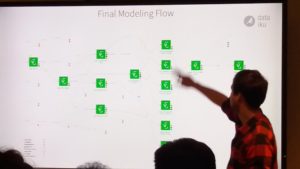Robot safety part 4: algorithms are the key
We are familiar with algorithms controlling the patterns of our life, from delivery cyclists to suggested purchases. John Kersey will look at some of the implications for safety.
“Someone told me that each equation I included in the book would halve the sales.” Stephen Hawking.

How data flocks around a reference point
At the CES 2018 technology fair in Las Vegas 250 drones fitted with light emitting diodes create an amazing series of patterns in the sky dazzling the onlookers on the ground. Each drone formats and keeps perfect station with its neighbour. Yet there are not 250 controllers operating these and no evidence of slight errors. How is this possible?
It is very probable that the controller is using a flock leader and the other drones take station from this using an algorithm. Ironically this could be a type of Birds Flocking algorithm first programmed by Craig Reynolds in 1986 in a simulation called Boids. Although here we see a literal use of the original model (the flocking behaviour of birds) being generated into a general computer model (an algorithm that expresses this) and turned into a literal application often this isn’t the case. The Bird Flocking algorithm can be used to look how data “flocks” around a reference point and may not have any flight application. This is the beauty of algorithms; once you model or describe a particular syndrome it can be used for another purpose. For example an algorithm used to evaluate credit ratings could be adapted to study risk ratings for enterprises.
Similarities in safety
In one sense safety professionals may already be familiar with algorithms from the simple examples used for asbestos priority based management plans. These look at simple factors assigned to:
- Material; such as product type, condition, surface type and asbestos type
- Priority based on occupant factors and likelihood of disturbance, human exposure potential and maintenance activity.
Using the assigned values these scores are added together and rated against a maximum score of 24. The algorithm here is only rating the order of the various situations and does not represent a direct model. For example chrysotile “white” asbestos is assigned a value of ‘1’ and crocidolite “blue” asbestos is assigned a value of ‘3’. It does not follow that crocidolite is three times more dangerous (it is held to be two or three orders of magnitude more dangerous) but the algorithm in a simple way puts it in a higher ranking. This is sufficient for this application.
As we have seen, data is the starting point however you need a tool to animate the data and make it work. This is the role of the algorithm. Just as any job requires the right tool so any task making use of data needs the right algorithm for analysis. There are classic algorithms and can do much heavy lifting. John MacCormick is his book “9 Algorithms that changed the future” outlines how these simple devices have led to major change in our daily lives:
- Search engine indexing
- PageRank
- Public key cryptography
- Error correcting codes
- Pattern recognition
- Data compression
- Databases
- Digital signatures
- Reliability and computability.
Taking one example from the list – PageRank. It’s what launched Google – imagine if you put a query and instead of results ranked by relevance you had to sort through a random selection?

Useful algorithms in safety
So making a task achievable in AI is partly around finding the right algorithm and its complementary technique. Algorithms continue to be “created” or invented or perhaps discovered and then described and published. In the world of safety a useful series of algorithms are those surrounding decision trees. These are very familiar to many safety professionals as the basis of fault tree analysis, root cause analysis and other such quantitative techniques. Within data science, decision trees will be used to sort and assign data to set features. Where there is a lot of historic accident data for example it can be firstly aligned using a linear regression sequence for example. Say you wished to then assign those incidents to agreed root causes, then they need an algorithm that will steer these incidents based on those features to the right destination or root cause. A random forest algorithm (first described by Tin Kan Ho in 1995 but powerfully extended by Leo Breimann in 2001) is a popular method in machine learning for this type of task as it will determine the optimum fit from the various examples. This forms the basis of later analysis and then the possibility of predicting results.
Further reading:
Robot safety – is the AI revolution here?
Robot safety part 2 – man smart, machine smarter
Robot safety part 3 – data is power
Disclaimer. The views expressed in this article are those of the author and do not necessarily represent those of any commercial, academic or professional institution I am associated with.
Robot safety part 4: algorithms are the key
We are familiar with algorithms controlling the patterns of our life, from delivery cyclists to suggested purchases. John Kersey will
John Kersey
SHP - Health and Safety News, Legislation, PPE, CPD and Resources Related Topics
New robot ‘dog’ reduces power workers’ time in confined spaces
Robots rock: How top trends from the edge of technology can transform health and safety
Robot safety: Investment programme aims to improve workplace safety


